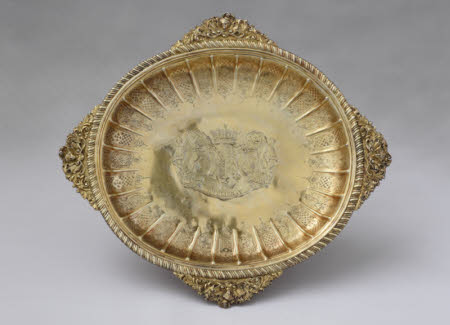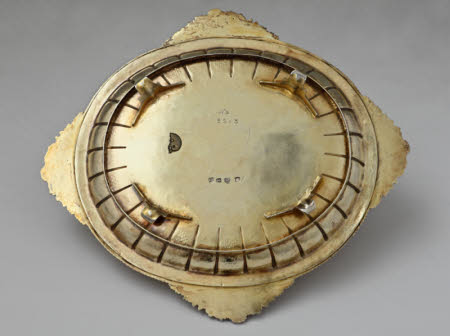Dish
Frederick Kandler
Category
Silver
Date
1751 - 1752
Materials
Silver-gilt
Measurements
4.4 x 33.7 x 30.2 cm
Place of origin
London
Order this imageCollection
Ickworth, Suffolk
NT 852064.2
Summary
Silver-gilt dessert dish, formerly a salad dish, by Frederick Kandler, 1751/2. The oval dish is raised and has a series of narrow ribs around the perimeter, the compartments thereby created being flat-chased and engraved with foliate strapwork panels, alternately decorated with stylised leaves on matted grounds and trelliswork. There is a cast gadrooned rim and four cast triangular handles, each with a three-dimensional classical bust against an irregular shell and scrolling foliage, the backgrounds matted. The base of the dish is fitted with a seamed bezel and four scroll feet. Heraldry: The centre of the dish is engraved with the quartered shield, supporters and motto of the 2nd Earl of Bristol in an ermine mantling and beneath an earl’s coronet.
Full description
This copy of the dish from the Scarsdale epergne (852064.1) is a superb pieces of craftsmanship and barely distinguishable from the original, being within an ounce of the same weight and even having a bezel which would have been redundant if not in use with the tureen of the epergne. Only on very close inspection can the slightest of variances be detected such as in the execution of the engraved borders and in the form of the panel and scroll feet. The four cast handles are precisely the same size which would suggest that Kandler had access to Lamerie’s moulds. Had he needed to take new ones from the original dish the copies thus produced would be expected to be fractionally smaller. It is possible that the epergne was not melted when this copy dish was made in 1751/2, and as it would have had a cover for the central tureen as well as the dish the latter would have been available for alternative use. This is typical of the 2nd Earl’s thrifty and measured approach to the augmentation of his plate as he thereby gained two dishes for the fashion cost of one. The gilding penetrates the engraved lines on both this dish and its Lamerie pair, suggesting that they were initially left white, perhaps until 1766 when the final two were added (852064.3-4). Thus they could have been intended to form part of the plate for the first courses of the meal, acting as salad dishes which, with their ribbing, they resemble. They may even have still been laid on the table with the epergne, perhaps flanking it, up to its demise c.1754. James Rothwell, Decorative Arts Curator January 2021 [Adapted from James Rothwell, Silver for Entertaining: The Ickworth Collection, London 2017, cat. 28 & 85, p. 106].
Provenance
Commissioned by the 2nd Earl of Bristol; by descent to the 4th Marquess of Bristol; accepted by the Treasury in lieu of death duties in 1956 and transferred to the National Trust.
Credit line
Ickworth, the Bristol Collection (National Trust)
Marks and inscriptions
Underside: Hallmarks: Fully marked with date letter ‘q’, lion passant, maker’s mark ‘FK’ in italics beneath a fleur-de-lis (Arthur Grimwade, London Goldsmiths 1697-1837, 1990, no. 691) and leopard’s head. Underside: Scratchweight: ‘N 2 [/] 32=3’ Underside: Remnants of old round white paper label with dark border – no writing visible.
Makers and roles
Frederick Kandler, goldsmith

